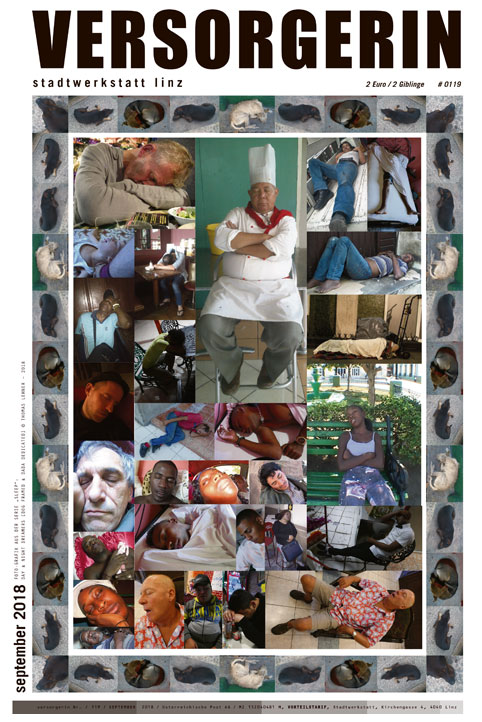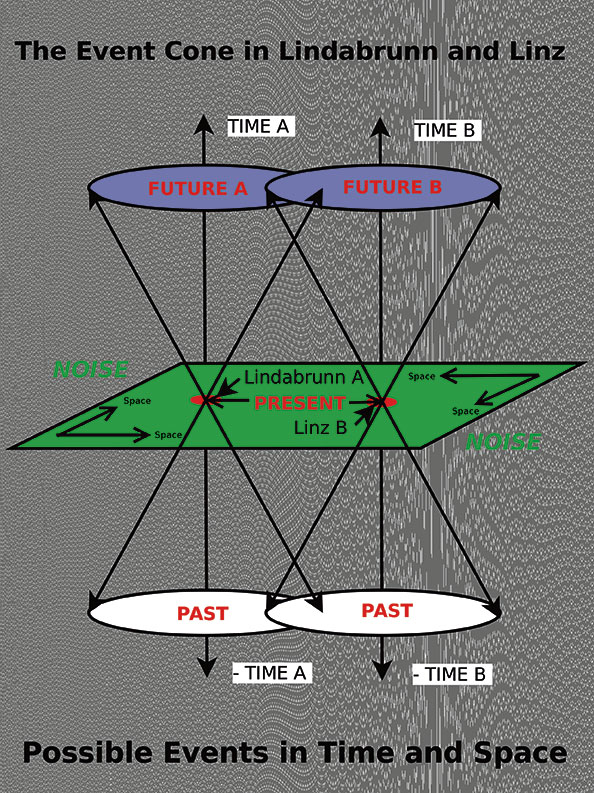»From Nothing to Something« is the subject of the Stadtwerkstatt‘s Infolab 2018 and a further stage to an artistic perspective that I have begun to establish already back in 1986 by reflecting on the aesthetics of the first homecomputer.
One year before at STWST48x3, in the Servus Clubraum, there was a little graphic where a noise transformed into a structure. In 2018, that will to be found as a 50 meter banner in the woods in Lindabrunn. Lindabrunn in Lower Austria is a parallel location of the STWST48x4 project »Nothing to Something«.
For me the triangle noise-computer-art originates from the Media Art of the 1980s. Back then, in Media Art it has not been about graphic, neither about composition of image or sound. It was about the first recursive processes in art. Processes that referred upon themselves, repeated themselves and therein changed themselves. Which resonated to Marshall McLuhan‘s »The Medium is the Message«. For me, Media Art therefore is a subgenre of Process Art. Another milestone inside this triangle was Douglas Hofstadter‘s »Gödel, Escher, Bach«.
30 years after such utopias had been formulated we are living in an information society in which, with the help of recursive programs, everything is about power and maximisation of profit (e.g. high frequency trading).
Powerless, politicians had to witness how global rules destroyed local rules and social structures. The individual is becoming a plaything to global logarithms, that, alongside the enlightenment process, cannot be stopped anymore.
True chaos and randomness however are also the preconditions to free will and to creativity. Alongside developments of information technology based on the theory of Claude Shannon the world was becoming ever more deterministic. Chaos and randomness became less prevalent in our everyday experience. As a consequence, also our potential to act in creative ways changed. As randomness became less prevalent it also became our most precious thing in cryptography and makes creative behaviour possible in the internet.
Infolab 2018 will be dedicated to the potential and the maintainance of these sources. It will also be about the disappearance of real-time information that was used in the artworks of the 1980s as they have obviously been superseded by the internet. Creativity and free will hence are dependent on an environment that is not acausal. This is and has been also the formula for success for evolution. Nature and evolution seem to aim at the development of deterministic information. Nature and evolution as opposites to the chaos and entropy of the universe.
In the developing information society the biggest problem for the individual seems to be a determined world order that prevents new ideas and utopias. The Infolab of the Stadtwerkstatt and the Verein Symposium Lindabrunn want to provide a solution. In the summer and fall of 2018, artists, activists and theorists are invited to Lindabrunn and to Linz to discuss these topics and utopias.
If we analyse creativity, we encounter randomness and spontaneousness. Spontaneousness happens in the present – the question arises: Has the present moment already passed when it is present? Despite computers becoming ever faster, they are not likely to reach the velocity of analogous processes so soon. Abstractions from and manipulations of the present will remain a domain of the analogous world.
With such questions we arrive at the level of smallest units of time, escape from our habitual everyday world and enter the quantum realm which provides new opportunities. At 5,391·10-44 seconds we have arrived at Planck time, the smallest period of time, the absolute present moment.
In the area of STWST48 and also in Lindabrunn the moment will become a central topic, when, in the week from September 10 to September 16 2018 it will be all about creativity. There will be real-time experiments meant to illustrate a new approach in art. In those events it will be about the synchronisation of our perception with the present and with randomness as a source. Consequently, we want to find correlations in the noise of our random generator in both places.
DAS EVENT: DAS GIS Orchestra
Performance: A Quantum of GIS
In a live performance the musicians of the GIS Orchestra will be conducted in real time via the atomic decay of the element Americium. A graphic projection allows the display of processes that happen at the subatomic level. For that, it is necessary for the individuals to be provided a framework in which such events can be contextualised. The primary factor is the synchronisation of the present. In popular music this happens via rhythm and beat. The beat enables synchronisation, i.e. a proclamation of presence and the present. Beat generates an intense emotional awareness of the present moment.
In the history of music and the digitalisation of society an acceleration of rhythm can be observed that, in its most radical forms »Speed«, »Gabba« or »Hard Tekkno« it comes in with 180 beats per minute and transports a sentiment of presence respectively an accelerated presence.
In the GIS Orchestra the beat of the drums and the bass section will be synchrosised via GPS and a time server. With a discrepancy of only 4nsec GPS is the most accurate system. Much more than that will be offered to the musicians as a metronome. Alongside that, a noise generator traces the noise of a semiconductor passage at the same rhythm.
In order to conduct the instruments of the GIS Orchestra there will be a converted webcam. The CMOS chip of a camera will not be exposed via photons but via Americium protons of a smoke detector and, therein, a source of randomness. The musicians react to a pattern of atomic decay that gets projected on a screen in front of them.
The GIS Orchestra (Go for Improvised Sounds) works with the principle of conducted improvisation. Previously defined signals coordinate the interplay of the orchestra of (approximately) 20 musicians. In the performance »A Quantum of GIS« the position of the conductor will be filled in parts with the globally synchronised GPS and the spontaneous atomic decay.
The coordination of the orchestra: Tim Boykett, Rainer Fehlinger, Gigi Gratt
RIP – RANDOMNESS IN PAST – Infolab 2018
Via quantum noise generators spaces of the Stadtwerkstatt get »connected« during the Ars Electronica in Linz and the symposium in Lindabrunn in Lower Austria. At each place it will be tried to detect the events of the other place within the noise of Linz and Lindabrunn.
Questions arise: Is there randomness in the past or does randomness need to happen always in the present? Is the present timeless and absolute? Is there space when there is no time?
Based on the idea of quantum entanglement, the maximum information content of true noise and the controversial results of the »Global Consciousness Project« of the Princeton University, we want to interlink Linz with Lindabrunn in the present moment.
This should happen via true noise. There have been various possibilities to create such a true noise. The basic idea is to create noise from areas in which natural laws get outmaneuvered, usually in areas of the microcosm and the macrocosm (quants and quasars).
There are theories that claim that in the noise of the quantum world or the cosmic microwave background the entire information of the world is contained. Which is also the reason why noise cannot be compressed with contemporary information technology. And why noise is both friend and foe to information theory. At both places of the event the quantum noise generated by a semiconductor gets recorded in blocks. Both locations are »virtually« entangled only via the present moment and »acausal« information. The starting time of both recorded noise blocks with a duration of one minute will be synchronised by a GPS signal. Researchers that work in experimental and artistic contexts will try to save those noise blocks in a blockchain as a »proof of chaos«.
With blockchain technology sequences of randomness from the past will be related to random values of the present. Therein, the past will become as important as the moment in which it occured. Such a blockchain creates a new foundation for crytography, free will and information technology and secures the maintainance of individual creativity in the information age. With this assembly it shall also be investigated if the quality of randomness is dependent on the present respectively how much this quality evaporates over time.
Why it should work: »You would not want to claim that the moon is not there when no one is looking at it?« Albert Einstein asked Niels Bohr, nearly 100 years ago, when quantum indeterminacy was discovered. In the subsequent 90 years the theory was ever more confirmed that reality gets influenced, maybe even generated, by the observer. Reality emerges as a convention. Briefly interpreted: We create the natural laws by ourselves. For the artistic avant-garde this implies taking care about not to degenerate into sarcasm and that quantum physicists do not deprive them of their position.
Translation: Philip Hautmann


